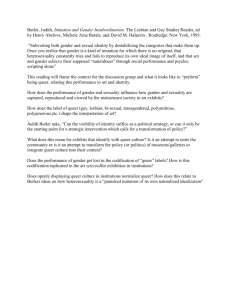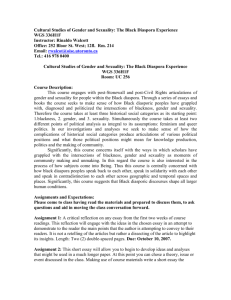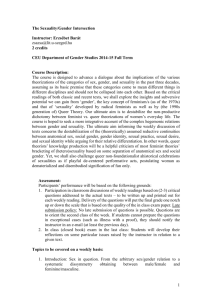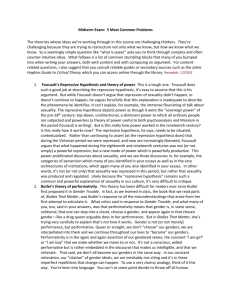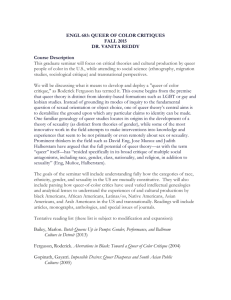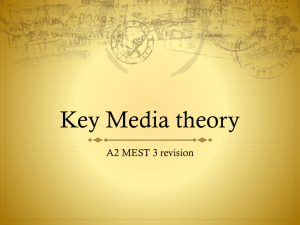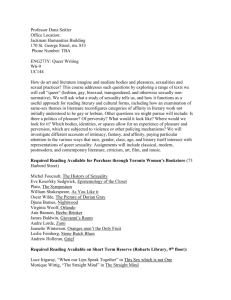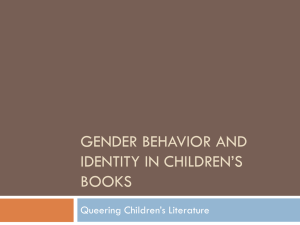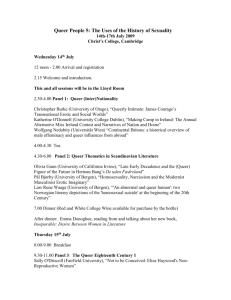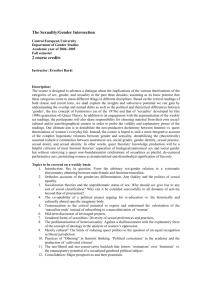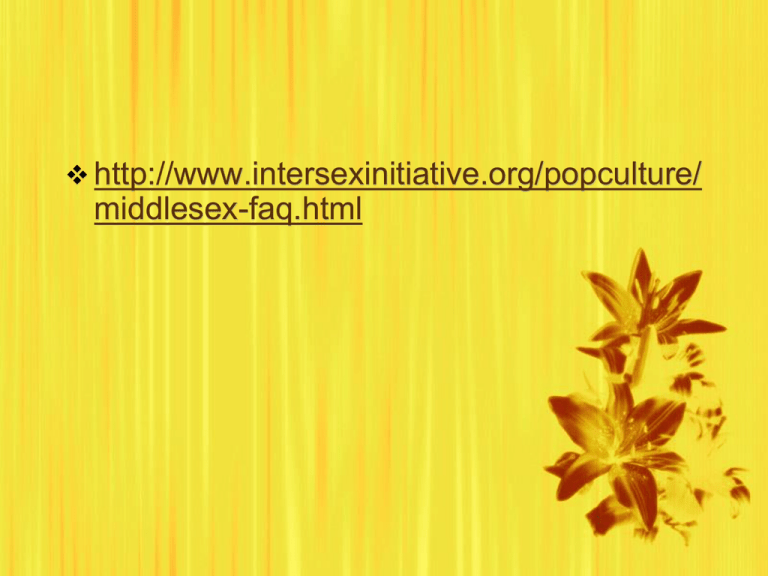
http://www.intersexinitiative.org/popculture/
middlesex-faq.html
Discussion Questions
Silkworm as metaphor
Ethnic/immigrant and intersex: intersections?
Doubleness
Sexuality
Oprah book?
69ers club and exploitation:
the business of the body
A Man vs The Man (518)
Gender and Sexuality:
Feminism to Queer Theory
Gender Studies:
Feminism
Feminisms
First Wave - rights
Second Wave - anti-essentialism, equality
Theories on Gender
• Essentialism: argues that differences
between men and women are natural
(biology)
• ‘Men are from Mars, women from Venus’
• Women are nurturers/emotional creatures
Radical Feminism
• Mid-1960s Radical feminist groups: women’s liberation
• Female revolution in consciousness
• Personal is political
• Collective action by women instead of individual
responsibility
• Analysis of love, marriage, sex, femininity
Foucault
• French philosopher Michel Foucault (1926-1984)
• Wrote The History of Sexuality. Vol. 1: The will to
knowledge (1976)
• Discourse (language/set of utterances) creates
phenomena and therefore has power
• Poststructuralist/postmodernist idea that discourse
structures the way we see reality
• Gender and sexuality are discursively constructed
Adrienne Rich
Essay ‘Compulsory Heterosexuality and
Lesbian Existence’ (1980)
Heterosexuality is an institution forced
upon women, predicated upon violence
Women are socialized into
‘heteroreality’
Why is heterosexuality ‘natural’?
Lesbianism has been written out of
history
Lesbianism is seen as abnormal
Critical Divides: Judith Butler's Body
Theory and the Question of Disability by Ellen
Samuel
“…the Aristotelian assertion that “‘the female is as it were a
deformed male' . . . not only does this definition of the female as
a 'mutilated male' inform later depictions of woman as
diminished man, but it also arranges somatic diversity into a
hierarchy of value that assigns completeness to some bodies and
deficiency to others’ (1997, 20). The notion that the disabled
body stands in a similar relationship to the nondisabled body as
the female does to the male has contributed, on the one hand, to
the development of sexist medical models which pathologize
female bodily functions such as pregnancy and menopause and
exclude women from research studies, and on the other hand, to
the de-masculinization of disabled men, who are then lumped
together with women, children, and the elderly in the realm of
abject and dependent bodies.
Lissa Paul
Feminism and Children’s Literature:
Agency
Feminisms
First Wave - rights
Second Wave - anti-essentialism, equality
Womanism and Third-World Feminism - beyond
gender, race, class, power
Third Wave - beyond gender, class, power
Neo-Marxist Materialist Feminisms
Queer Theory - Othered spaces, liminality,
sexuality (at first)
Queer theory
• Strategy of disruption of binaries
(male/female; homo-/heterosexual)
• Denaturalisation of categories
• Against essentialism
• Body ≠ Gender ≠ Desire (disconnected)
• Postmodern
Judith Butler (Queer theorist)
• Butler,Gender trouble (1990)
• Gender is performative: gender is
what
you do, not what you are
• Performances can be words or
behaviour,
done to us (midwife: ‘it’s a girl’) and by
us
(drag queen)
• ‘It’s a girl!’: not a neutral description
of a
female identity, but a performative
statement: it constitutes the sexed
body
Judith Butler
• Gender is socially constructed,
but
appears natural
• Postmodernist because Butler
does not
believe in pre-existing core
identities
Third way
• Other theorists study the social
construction of women’s sexuality and pay
attention to bodily experiences:
• Third Way
“The work of mestiza consciousness is to
break down the subject-object duality that
keeps her a prisoner and to show in the
flesh and through the images in her work
how duality is transcended”
Gloria Anzaldua Borderlands/La Frontera:
The New Mestiza (1987, 102)
Queer Theory
Homosexuality
Transsexuality
Intersexuality
Third Space (Chela Sandoval, third-world feminism)--
both/and, transgression, ambiguity, borderlands,
transformation, disruption, revision, reversal
Haraway's cyborg, a hybrid of machine and organism,
challenges notions of purity, thereby resisting
totalizing (coding) practices in a techno-scientific
context. Specifically, her cyborg represents a thirdspace practice of recoding that blurs the boundaries
between the technical and the organic.
Gayatri Chakravorty Spivak explains that the
term "Third World" was initially coined in 1955
by those emerging from the "old" world order:
"the initial attempt in the Bandung Conference
(1955) to establish a third way -- neither with
the Eastern nor within the Western bloc -- in
the world system, in response to the
seemingly new world order established after
the Second World War, was not accompanied
by a commensurate intellectual effort. The
only idioms deployed for the nurturing of this
nascent Third World in the cultural field
belonged then to positions emerging from
resistance within the supposedly 'old' world
order -- anti-imperialism, and/or nationalism"
(270).
“The intersexed body clearly challenges conceptual
categories. It therefore can serve, like drag, as a
case study aimed at both stimulating and troubling
theoretical attempts to account for the social
construction of gender, especially the relations
among gender, sexuality, and the body. But
because real people also inhabit intersexed bodies,
suffering the social consequences of their exclusion
from normatively categorized identities, more is
obviously at stake in thinking about intersexuality
than theory itself, as scholars such as Anne Fausto
Sterling, Alice Domurat Dreger, and Suzanne J.
Kessler have been mindful. The potential challenge
uncovered by the exploration of the intersexed
body echoes a problem that recurs in such political
criticisms as feminism: the act of description, with
its concomitant act of theorizing, does not
necessarily support activism in the world, a politics
of social change that might alter the lives of those
who live on the margins.”
"The book, like its hermaphroditic narrator, was
meant to be a hybrid. Part third-person epic, part
first-person coming-of-age tale" ("Eugenides"
76).
“Two narrative components of Middlesex-the
immigrant family epic and the hermaphrodite's
coming-of-age memoir-to attempt to bring into
alignment the discourses of gender and ethnic
identity.”
“Both rely upon the principle of a social
imaginary, what Rosi Braidotti terms the ‘set of
socially mediated practices that function as the
anchoring point-albeit contingent-or framing and
shaping the constitution of the subject and
therefore for identity formation’ ("BecomingWoman" 384).”
Origin of Love
Aristophanes’s Speech from Plato’s
Symposium
Suzanne Kessler
“The Medical Construction of Gender:
Case Management of Intersexed
Infants,” Signs 16 (1990): 3-26
Anne Fausto-Sterling,
developmental geneticist and
professor of medical science at
Brown
“The Five Sexes: Why Male and Female are not
Enough” (The Sciences, 1993)
“For biologically speaking, there are many
gradations running form female to male; and
depending on how one calls the shots, one can
argue that along that spectrum lie at least five
sexes--and perhaps even more.”
Those born outside of the Platonic dimorphic
mold are called intersexuals.
“herms,” “merms,” and “ferms”
Michel Foucault
Biopower
“the knowledge developed in biochemistry,
embryology, endocrinology, psychology
and surgery has enabled physicians to
control the very sex of the human body.”
free people from pain of not being one or
the other in a sex divided culture
Fausto-Sterling’s provocative yet slightly
tongue-in-cheek position is to completely
rethink gender. More seriously she would
suggest that we at least rethink the
medical and ethical principles of
permanently “fixing” intersexuality in
children, and to question our trust in
gender as a reliable, fixed two-party
binary.
“Success,” by the way, is often marked by
living as a heterosexual and other gender
normative assumptions.
“Sometimes people suggest to me, with not a little
horror, that I am arguing for a pastel world in
which androgyny reigns and men and women are
boringly the same. In my vision, however, strong
colors coexist with pastels. There are and will
continue to be highly masculine people out there;
it's just that some of them are women. And some
of the most feminine people I know happen to be
men.”
This kind of celebration and
validation of difference, as it is
manifested in body parts as well as
bodily practices, underpins the
ideology of what has come to be
called Queer theory. Rather than
focus on specific sexual acts or
object-choices, queer theory affirms
the diversity of the potential
identities available to those
marginalized and pathologized by
normative models of heterosexuality.
In recent years, scholars in a variety of disciplines, from sociology to
physics, have undertaken to challenge the longstanding, pervasive
dichotomy between nature and culture. In disciplines devoted to the
study of human beings, that dichotomy takes the form of a division
between those aspects of our existence that are given at birth, and
those that are shellacked onto us by the societies in which we live. The
divergent scholars ["developmental systems theorists”] who challenge
this dichotomy argue that its sharpness actually serves to distort, not
clarify, our understanding of human development. In its place, some of
these scholars have offered interpretations of the relation between
nature and culture that attempt to show that the physical and the social
aspects of human being are actually mutually constitutive, and are
comprehensible only in relation to each other.
”[D]evelopmental systems theorists…deny that there are fundamentally
two kinds of processes: one guided by genes, hormones, and brain cells
(that is, nature), the other by the environment, experience, learning, or
inchoate social forces (that is, nurture)" (p. 25). Instead, systems
theorists seek explanations that understand every process, every state,
every entity as a complex interaction between so-called "natural" and
so-called "cultural" elements.
This essay aims to complicate the picture by arguing for a
queer reading of the Metamorphoses and the myth of
Hermaphroditus and Salmacis, in particular. It will contend
that Ovid’s myth provides an etiological narrative of complex
sexual identity that originates in but transcends antiquity to
provide a critique of what Judith Butler (2004, 65) has called
the idealized gender dimorphism of the present day. This
narrative speaks especially to the multiple, often overlapping
identities assumed by the person who identifies as queer or as
intersexual. The essay has a two-pronged trajectory:
examining both how the later developments of feminist and
queer theory informed by psychoanalysis have employed
Ovidian myth within their own master narratives as they seek
to understand the human subject; and using this body of
theory as an interpretative lens for the myth itself, offering a
reading that engages transformation as the vehicle of
meaning for gender identity.

